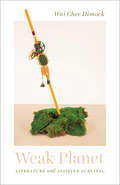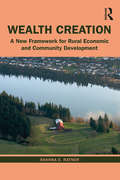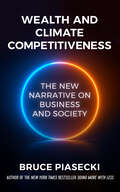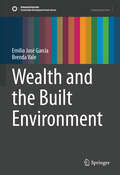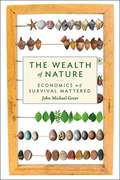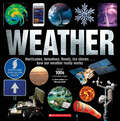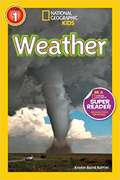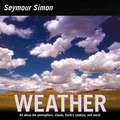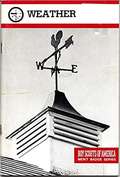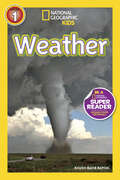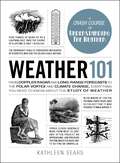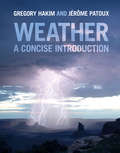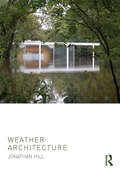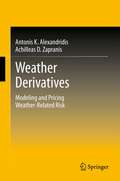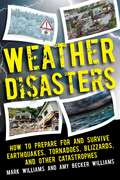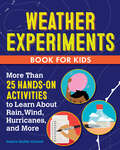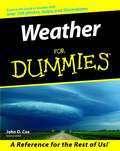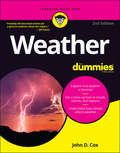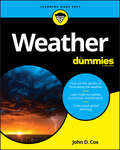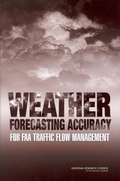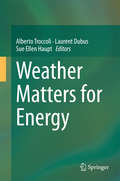- Table View
- List View
Weak Planet: Literature and Assisted Survival
by Wai Chee Dimock“Exploring weakness and vulnerability from the origins of American literature to the present, she provocatively argues for ‘collateral resilience.’” —Viet Thanh Nguyen, Pulitzer Prize–winning authorVulnerability. We see it everywhere. In once permanent institutions. In runaway pandemics. In democracy itself. And most frighteningly, in ecosystems with no sustainable future. Against these large-scale hazards of climate change, what can literature teach us? This is the question Wai Chee Dimock asks in Weak Planet, proposing a way forward, inspired by works that survive through kinship with strangers and with the nonhuman world.Drawing on Native American studies, disability studies, and environmental humanities, Dimock shows how hope can be found not in heroic statements but in incremental and unspectacular teamwork. Reversing the usual focus on hegemonic institutions, she highlights instead incomplete gestures given an afterlife with the help of others. She looks at Louise Erdrich’s and Sherman Alexie’s user-amended captivity narratives; nontragic sequels to Moby-Dick by C. L. R. James, Frank Stella, and Amitav Ghosh; induced forms of Irishness in Henry James, Colm Tóibín, W. B. Yeats, and Gish Jen; and the experimentations afforded by a blurry Islam in works by Henri Matisse, James Joyce, Ezra Pound, and Langston Hughes. Celebrating literature’s durability as an assisted outcome, Weak Planet gives us new ways to think about our collective future.“Weak Planet invites us to reflect on the deep interconnections between two threatened extinctions: that of the humanities and that of a host of animal species (not least our own). The book is nothing short of a radical reorientation of literary history.” —Stephen Best, author of None Like Us: Blackness, Belonging, Aesthetic Life
Wealth Creation: A New Framework for Rural Economic and Community Development
by Shanna E. RatnerA new approach to rural development is emerging. Instead of being about attracting companies that might create jobs over which communities have no control, the emerging paradigm is about connecting the unique underutilized assets of place with market opportunity to grow assets that are owned and controlled by and for the benefit of low-wealth people and places. But asset development is about more than bricks and mortar or narrowly defined financial assets. There are many kinds of assets that communities require to thrive – such as social capital, natural capital, political capital, and intellectual capital. The emerging new approach to rural development is, then about broadening the definition of "wealth," engaging underutilized assets, and a key third element: harnessing the power of the market – rather than relying solely on philanthropy and government. Wealth Creation provides a conceptual guide with practical examples for policymakers, practitioners of economic and community development, community organizers, environmentalists, funders, investors, and corporations seeking a values-based framework for identifying self-interests across sectors that can lead to opportunities to transform existing systems for the collective good.
Wealth and Climate Competitiveness: The New Narrative on Business and Society
by Bruce PiaseckiA new book from New York Times bestselling author Bruce Piasecki, Wealth and Climate Competitiveness explores how wealth, both private and corporate, can assist the path to climate competitiveness. Many of the central concerns of the twenty-first century—racial inequity, white supremacy movements, greater inclusiveness of diverse peoples—are rooted in facing and overcoming prejudices, both common and hidden. Another great challenge—the role of wealth and innovation in solving the climate crisis—is also riddled with disabling prejudices about how corporations work, and about the rights and needs of consumers and world citizens. In his twenty-first book, Wealth and Climate Competitiveness: The New Narrative on Business and Society, Bruce Piasecki argues that a set of five recurring prejudices, from 1900 to 2020, have held up real progress on climate action. Using the examples of select firms like Trane Technologies, and oil giants like the transforming bp, Piasecki sets out to define climate competitiveness as a path to solutions that decarbonize, decentralize, and digitize our near future. Climate competitiveness involves a responsible, steady, resolve-based focus on lessons derived from human behavior and social movements. By using Robin Hood as a narrative example, this book is designed to give you a deep understanding of the changed landscape we now face, and how you can resolve to embrace climate competitiveness to drive your personal success, and the corporate and institutional success of our world.
Wealth and the Built Environment (Sustainable Development Goals Series)
by Brenda Vale Emilio José GarcíaThe need to address global environmental problems is urgent. The United Nations 17 Sustainable Development Goals (SDGs) cover a wide range of global concerns, from poverty, hunger, and gender equity to justice and climate action. Concerningly, the SDGs still have faith in economic growth and technological innovation as the means of fixing all global concerns, including climate change. What is not questioned is whether solving development and sustainability problems through economic growth for the accumulation of wealth for the few has led to many of the current unequal development and environmental problems. If unfair growth and wealth accumulation have been part of the problem, how can they be part of the solution? The problem with the SDGs is that their fulfilment relies on wealth creation without the fundamental concomitant of wealth redistribution. The one common driver of change affecting both sustainability and development that has not been included in the SDGs is wealth, the central focus of this book. SDG 11 – sustainable cities and communities – presents a further paradox unless the issue of wealth and its fair distribution is grasped. Cities are the places where wealth is generated but are also places where only a minority are wealthy. The wealth generated in cities leads to higher consumption of resources, higher emissions, and higher disparities and inequalities. However, any version of a sustainable future will happen in the built environment made according to current ideals, like the present belief in overcoming all humanity's problems by becoming wealthier. A fundamental assumption of this book is that the first step toward a fairer habitat that can maintained with the resources available is only possible if we stop designing cities and buildings as if everyone were wealthy or had to become wealthy. To achieve this goal, it is essential to identify and raise awareness of the impact of wealth, to question how the myths about the advantages of wealth were built, where they come from, what shape they take in the built environment and who benefits from them.
Wealth of Nature: Economics as if Survival Mattered
by John Michael GreerJohn Michael Greer has re-thought economics, starting from its fundamental premises, giving it a basis in ecological reality rather than political fiction. The result is perhaps the most important and readable book on economics since Small Is Beautiful. Richard Heinberg, author of The End of Growth.
Weather
by John Farndon Sean Callery Miranda SmithFrom wild tornadoes to blinding blizzards, learn what makes our climate and weather work in this stunning visual guide.Fiercer hurricanes, hungrier wildfires, flash floods, and desertification are becoming a part of daily life as our climate shifts and changes. Weather covers the most important areas of this timely topic, delivering up-to-date expert information on everything from the water cycle to winds, cloud galleries, fog, and snow, and from extreme weather like hurricanes, supercell tornadoes, firestorms, and dust storms to the people who predict them and try to save others.Beautifully laid out images of weather objects and processes using satellite imagery, time-lapse photography, and eyewitness reportage put readers in the eye of the storm for close-up learning. A must-read for curious young scientists interested in the weather systems that shape our world.
Weather
by Kristin Baird RattiniExplores the causes of everyday weather phenomena, including how clouds form, why tornadoes twist, and how the sun helps life grow.
Weather
by Seymour SimonEver wonder what makes the wind blow? Or where clouds come from, or rain? Every day you experience weather, but why do you experience the weather you do?<P><P> Explore weather, a subject that changes every day, with award-winning science writer Seymour Simon.
Weather (Merit Badge Series)
by Boy Scouts of AmericaThis book introduces scouts to the science of weather.
Weather (National Geographic Readers)
by Kristin Baird RattiniNIMAC-sourced textbook <P><P>What causes thunder and lightning? How do different clouds form? What makes a tornado twist? Kids will discover the answers to these questions and more in this colorful, photo-packed book. In this inviting and entertaining format, kids will discover what causes the weather they experience every day. This level 1 reader is written in an easy-to-grasp style to encourage the meteorologists of tomorrow!
Weather (Readers)
by Kristin Baird RattiniWhat causes thunder and lightning? How do different clouds form? What makes a tornado twist? Kids will discover the answers to these questons and more in this colorful, photo-packed book. In this inviting and entertaining format, kids will discover what causes the weather they experience every day. This Level 1 reader is written in an easy-to-grasp style to encourage the meteorologists of tomorrow!
Weather 101: From Doppler Radar and Long-Range Forecasts to the Polar Vortex and Climate Change, Everything You Need to Know about the Study of Weather (Adams 101 Series)
by Kathleen SearsIn this clear and straight new guide from the author of Grammar 101 and Weather 101, get a crash course in understanding the science behind weather and weather prediction.Weather is everywhere, and while it&’s typically not thought about most of the time, it can get everyone&’s attention in an instant—whether it&’s the swirling destruction of a tornado, the wreckage from a hurricane, or the havoc of climate change on the environment. Weather 101 gives you the basics on weather, from blue skies to hail to dust storms, with information on the science of how weather works, how to predict the weather in your area, how to be ready for natural disasters, and how climate change is affecting weather patterns across the world. With this guide, you&’ll be a weather expert in no time!
Weather A Concise Introduction
by Gregory Hakim J賴me PatouxFrom a world-renowned team at the Department of Atmospheric Sciences at the University of Washington, Seattle, Weather: A Concise Introduction is an accessible and beautifully illustrated text covering the foundations of meteorology in a concise, clear, and engaging manner. Designed to provide students with a strong foundation in the physical, dynamical, and chemical processes taking place in the atmosphere, this introductory textbook will appeal to students with a wide range of mathematical and scientific backgrounds. This textbook features: a single case study of a mid-latitude cyclone which is referred to throughout the whole book to illustrate the basic principles driving atmospheric dynamics and phenomena; boxes on more advanced topics; appendices for additional coverage; chapter summaries listing the 'take-home' points discussed; and colour figures and charts illustrating the fundamental concepts. Key terms are evident throughout, and a glossary explains the terms that students will need to understand and become familiar with.
Weather And Climate
by Winston Staff Rinehart HoltExploring, inventing, and investigating are essential to the study of science. However, these activities can also be dangerous. To make sure that your experiments and explorations are safe, you must be aware of a variety of safety guidelines.
Weather Architecture
by Jonathan HillWeather Architecture further extends Jonathan Hill’s investigation of authorship by recognising the creativity of the weather. At a time when environmental awareness is of growing relevance, the overriding aim is to understand a history of architecture as a history of weather and thus to consider the weather as an architectural author that affects design, construction and use in a creative dialogue with other authors such as the architect and user. Environmental discussions in architecture tend to focus on the practical or the poetic but here they are considered together. Rather than investigate architecture’s relations to the weather in isolation, they are integrated into a wider discussion of cultural and social influences on architecture. The analysis of weather’s effects on the design and experience of specific buildings and gardens is interwoven with a historical survey of changing attitudes to the weather in the arts, sciences and society, leading to a critical re-evaluation of contemporary responses to climate change.
Weather Derivatives
by Achilleas D. Zapranis Antonis Alexandridis K.Weather derivatives are financial instruments that can be used by organizations or individuals as part of a risk management strategy to minimize risk associated with adverse or unexpected weather conditions. Just as traditional contingent claims, a weather derivative has an underlying measure, such as: rainfall, wind, snow or temperature. Nearly $1 trillion of the U.S. economy is directly exposed to weather-related risk. More precisely, almost 30% of the U.S. economy and 70% of U.S. companies are affected by weather. The purpose of this monograph is to conduct an in-depth analysis of financial products that are traded in the weather market. Presenting a pricing and modeling approach for weather derivatives written on various underlying weather variables will help students, researchers, and industry professionals accurately price weather derivatives, and will provide strategies for effectively hedging against weather-related risk. This book will link the mathematical aspects of the modeling procedure of weather variables to the financial markets and the pricing of weather derivatives. Very little has been published in the area of weather risk, and this volume will appeal to graduate-level students and researchers studying financial mathematics, risk management, or energy finance, in addition to investors and professionals within the financial services industry.
Weather Disasters: How to Prepare For and Survive Earthquakes, Tornadoes, Blizzards, and Other Catastrophes
by Mark D. Williams Amy Becker WilliamsFloods. Blizzards. Landslides. Earthquakes. Tornadoes. Hurricanes. Severe weather happens every day across the globe. We see and hear of the devastating consequences whenever we tune into the evening news: property ravaged, communities destroyed, and lives lost. But although these events are unstoppable, you can prepare. In Weather Disasters, veteran authors and disaster survivors Mark and Amy Williams provide vital information on prepping for and surviving every major type of weather disaster. Each chapter is devoted to a different catastrophe, and lists: The science behind the catastrophe Essentials you’ll need to get through it Helpful prepping tips Statistics behind the disaster Resources to reach out to for help What to do in the aftermath No matter who you are or where you live, catastrophe can strike at any time. Be prepared, and pick up Weather Disasters today!
Weather Experiments Book for Kids: More Than 25 Hands-On Activities to Learn about Rain, Wind, Hurricanes, and More
by Jessica Stoller-ConradHelp kids ages 8 to 12 experiment like scientists and discover the world of weather! What makes the weather change? What happens in the sky when storm clouds form? The Weather Experiments Book for Kids does more than just explain how weather events work—it lets kids see weather in action! Discover 25 fun experiments kids can create right at home, and explore fascinating weather like rain, clouds, tornadoes, and more! What's weather, anyway?—Kids will get a quick introduction to the difference between weather, climate, and atmosphere, and all the factors that affect what it looks like outside each day. Get hands-on—Kids will make their own barometer that measures atmospheric pressure, create clouds with water and hairspray, test soil conditions, and more. Independent learning—These experiments are designed with easy instructions and materials so kids can do them with minimal help from adults. Discover more than other weather books for kids with experiments that make weather come to life!
Weather For Dummies
by John D. CoxWhat's going on up there when the rain falls, when the wind blows, when the clouds roll in and the lightning flashes? How do hurricanes arise and where to tornadoes come from? Why do seasonal conditions sometimes vary so much from one year to the next? Our ways of life, our very existences depend on knowing the answers to questions like these. Economies have been wiped out, civilizations have risen and fallen, entire species have come into being or gone extinct because of a temperature shift of just a few degrees, or a brief shortage or glut of rainfall. With so much riding on the weather, it makes you wonder how you've lived this long without knowing more about it. Don't worry it's never too late to find out about what makes the weather tick. And there's never been an easier or more enjoyable way to learn than Weather For Dummies. In know time, you'll know enough of weather basics to be able to: Identify cloud types Make sense of seasonal differences in the weather Understand what causes hurricanes, tornadoes, and other extreme events Make your own weather forecasts Avoid danger during severe weather Understand the global warming debate Get a handle on smog, the greenhouse effect, El Niño, and more Award-winning science writer John D. Cox brings the science of meteorology down to earth and, with the help of dozens of cool maps and charts and stunning photographs of weather conditions, he covers a wide range of fascinating subjects, including: What is weather and how it fits into the entire global ecosystem What goes into making a professional daily weather forecast The basic elements of weather, including air pressure, clouds, and humidity Storms, hurricanes, tornadoes, monsoons, and other extreme forms of weather Seasonal weather effects and why they vary Lightening, rainbows, sundogs, haloes, and other special effects Featuring clear explanations, stunning illustrations, and fun, easy experiments and activities you can do at home , Weather For Dummies is your guide to making sense of the baffling turmoil of the ever-changing skies above.
Weather For Dummies
by John D. CoxWhat in the world is going on up there? Look up! It’s a bird; it’s a plane; it’s a Polar mesospheric cloud! When you look to the sky, do you wonder why the Sun is so bright or why the clouds are white or why the sky is blue? Then, Weather For Dummies is your resource to fuel your curiosity about the weather. It takes you on an exciting journey through the Earth's atmosphere and the ways it behaves. You’ll get an overview of rain, Sun, clouds, storms and other phenomena. With helpful photographs and illustrations, you can easily visualize different weather types and relate them into the world around you. The scientific words and phrases are explained in detail (what is barometric pressure?), your curious questions are answered (why do we have seasons?), and the roots of weather myths, proverbs, and sayings are revealed (“early thunder, early spring”). Discover how weather forecasts are made, and what constitutes a weather emergency Find out what causes change in weather, such as how air pressure drives winds Learn how climate change is affecting today’s weather Discover how light plays tricks on our eyes to create effects like rainbows, sun dogs, and halos Have fun with at-home weather experiments, including setting up your own weather station Perfect for any weather amateur, you can have your head in the clouds while your feet are on the ground. Next time you’re outside, take Weather For Dummies along with you, look at the sky, and discover something new about the environment you live in.
Weather For Dummies (For Dummies Ser.)
by John D. CoxWhat's going on up there when the rain falls, when the wind blows, when the clouds roll in and the lightning flashes? How do hurricanes arise and where to tornadoes come from? Why do seasonal conditions sometimes vary so much from one year to the next? Our ways of life, our very existences depend on knowing the answers to questions like these. Economies have been wiped out, civilizations have risen and fallen, entire species have come into being or gone extinct because of a temperature shift of just a few degrees, or a brief shortage or glut of rainfall. With so much riding on the weather, it makes you wonder how you've lived this long without knowing more about it. Don't worry it's never too late to find out about what makes the weather tick. And there's never been an easier or more enjoyable way to learn than Weather For Dummies. In know time, you'll know enough of weather basics to be able to: · Identify cloud types · Make sense of seasonal differences in the weather · Understand what causes hurricanes, tornadoes, and other extreme events · Make your own weather forecasts · Avoid danger during severe weather · Understand the global warming debate · Get a handle on smog, the greenhouse effect, El Niño, and more Award-winning science writer John D. Cox brings the science of meteorology down to earth and, with the help of dozens of cool maps and charts and stunning photographs of weather conditions, he covers a wide range of fascinating subjects, including: · What is weather and how it fits into the entire global ecosystem · What goes into making a professional daily weather forecast · The basic elements of weather, including air pressure, clouds, and humidity · Storms, hurricanes, tornadoes, monsoons, and other extreme forms of weather · Seasonal weather effects and why they vary · Lightening, rainbows, sundogs, haloes, and other special effects Featuring clear explanations, stunning illustrations, and fun, easy experiments and activities you can do at home , Weather For Dummies is your guide to making sense of the baffling turmoil of the ever-changing skies above. P.S. If you think this book seems familiar, you're probably right. The Dummies team updated the cover and design to give the book a fresh feel, but the content is the same as the previous release of Weather For Dummies (9780764552434). The book you see here shouldn't be considered a new or updated product. But if you're in the mood to learn something new, check out some of our other books. We're always writing about new topics!
Weather Forecasting
by Gail GibbonsWill I need my umbrella? Is it a good day for the beach? Will school close because of snow? These are the questions weather forecasters answer every day. They can tell us what the weather is doing at any time of the day or night. But how do they do it? Weather Forecasting tells how. <P><P>With straightforward text and colorful pictures, this behind-the-scenes look at a modern weather station answers basic questions kids ask most, and makes weather forecasting more fun and accessible than ever.
Weather Forecasting Accuracy For Faa Traffic Flow Management: A Workshop Report
by Committee for a Workshop on Weather Forecasting Accuracy for FAA Air Traffic ControlAccurate prediction of convective storms 2- to 6-hours in advance is critical to selecting air traffic routes with minimal weather delays or diversions. This report summarizes the discussions of a workshop to explore present convective weather forecasting skill, strategies for improving that skill, ways to verify forecasts are accurate, and how to make forecasts useful to air traffic controllers, airline dispatchers, and pilots.
Weather Instruments
by Delta EducationAn introduction to weather instruments for third and fourth grade.
Weather Matters for Energy
by Alberto Troccoli Laurent Dubus Sue Ellen HauptIt is the purpose of this book to provide the meteorological knowledge and tools to improve the risk management of energy industry decisions, ranging from the long term finance and engineering planning assessments to the short term operational measures for scheduling and maintenance. Most of the chapters in this book are based on presentations given at the inaugural International Conference Energy & Meteorology (ICEM), held in the Gold Coast, Australia, 8-11 November 2011. The main aim of the conference was to strengthen the link between Energy and Meteorology, so as to make meteorological information more relevant to the planning and operations of the energy sector. The ultimate goal would be to make the best use of weather and climate data in order to achieve a more efficient use of energy sources. This book seeks to realise the same objective.
